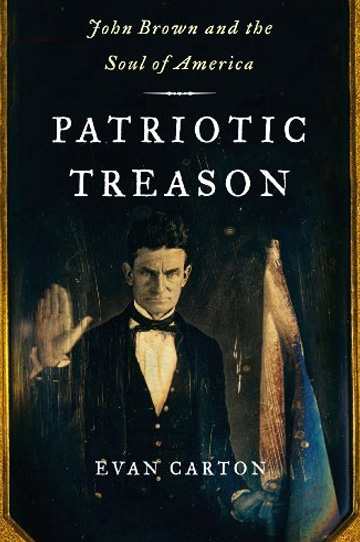
Brown Pursued Just Ideas to Bloody End
October 23, 2006 | San Francisco Chronicle
Frederick Douglass , who escaped slavery and became America’s most eloquent black abolitionist, said, “To have been acquainted with John Brown, shared his counsels, enjoyed his confidence, sympathized with the great objects of his life and death, I esteem as among the highest privileges of my life.” Brown — America’s antislavery revolutionary, a white man who was executed in 1859 for treason and murder — tried repeatedly but failed to win Douglass’ support for Brown’s plan to raid the federal armory at Harpers Ferry, Va., where he hoped to arm the slaves of the South for an uprising against their masters. But even if Douglass disapproved of Brown’s violent means, he was amazed that a white man’s hatred of slavery could surpass his own, which he called a “taper light” next to Brown’s “burning sun.”
Brown spent most of his adult life preparing for Harpers Ferry, whether by debating with Douglass, fundraising among Northeastern abolitionists, studying the insurrectionist tactics of Haiti’s black guerrillas or pacing the battlefields of Waterloo. Such a bold plan was likely to fail, and his did, at least superficially. Brown and his 18 men were stopped 36 hours into the raid by federal troops led by Robert E. Lee. Virginia’s slaves had not, as Brown had predicted, rushed to revolt. Evan Carton, in “Patriotic Treason,” keenly observes that Brown was overconfident they would rise up because most of the blacks he knew were militants and escaped slaves.
But viewed broadly, Harpers Ferry was by no means a failure. The sheer audacity of the raid, coupled with Brown’s powerful, plainspoken defense of it afterward (Carton and other revisionists have completely discredited the notion that Brown was a madman), sent a chill down the South’s spine. Brown had shown that Southerners were not the only ones capable of defending their views with force, so when Lincoln was elected a year later as the nation’s first antislavery president — albeit one who did not share Brown’s radical views — Southerners deemed it an unacceptable provocation and started seceding.
They were terrified of Brown, and with reason. Before Harpers Ferry, he sharpened his sword in the battlefields of Kansas, where federal law established that the territory’s residents could determine for themselves whether to allow slavery. Pro-slavery Missourians streamed in to unbalance the vote, murdering scores of free-staters in the process. Brown and his sons descended, summoning from their beds five pro-slavery rabble-rousers and cutting them down with broadswords. He also liberated 11 slaves at gunpoint and spirited them to Canada.
Carton, a professor of American literature, tries to show through narrative history what Brown’s life was like, “to dramatize the thoughts and feelings, the lived experience” of the man and his contemporaries. “Patriotic Treason” tells a story (and tells it well) rather than providing analysis; it adds little new information or insight. Still, it is an engaging and accessible read, a solid short version of Brown’s life. (Readers seeking a feel for the strain of living with Brown’s uncompromising moral certainty — his “belief in an absolute north,” as Carton nicely puts it — would also do well with the excellent novels “Cloudsplitter,” by Russell Banks, and Marilynne Robinson‘s “Gilead.”)
Throughout the book, Carton emphasizes Brown’s deep Calvinist faith as well as his status as something of a deadbeat dad (antislavery work took him away from his family for months at a time). He was also an egalitarian in matters of race when almost everyone around him was a bigot. Most Northerners opposed the spread of slavery because they didn’t want to live with blacks or compete with them for jobs, and even abolitionists paternalistically viewed blacks as inferiors. More than a few chafed, then, when they visited Brown’s home, the only white residence in a farming community of free blacks, or when they dined at his table, where blacks ate alongside their white brethren. One of Brown’s remarkable demonstrations of solidarity with black people came in 1836 in an Ohio church where blacks were consigned to pews in the back. Each day, Brown and his family walked to the black section of the church, invited a black family to the front, and seated them in the Brown family pew. They would then take the black family’s place in the back. They were expelled for their impertinence.
Carton admires Brown’s pluck but is less of a partisan than his previous biographer, David Reynolds. For instance, competing witnesses described the precise language Brown used in 1837 when he dramatically rose in another church, raised his right hand and pledged to fight slavery for the rest of his life. Carton, unlike Reynolds and several others biographers, describes both versions and rightly favors the less sexy wording, which was provided contemporaneously by two dispassionate witnesses, whereas the other version was boasted years later by Brown’s half brother. But, semantics aside, the point is that Brown did make the pledge, and he carried it out. He was uncompromising and demanding and he went too far in Kansas with a horrifying act of political terrorism. But he was right about slavery when almost nobody else was, and he fought it harder than any other American. “I believe in the Golden Rule, sir, and the Declaration of Independence,” he once said. “I think that both mean the same thing.”